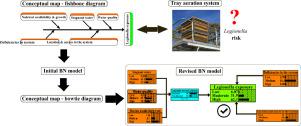Water Research ( IF 11.4 ) Pub Date : 2021-01-19 , DOI: 10.1016/j.watres.2021.116854 Danladi Yunana , Stuart Maclaine , Keng Han Tng , Luke Zappia , Ian Bradley , David Roser , Greg Leslie , C. Raina MacIntyre , Pierre Le-Clech

|
An Australian water utility has developed a Legionella High Level Risk Assessment (LHLRA) which provides a semi-qualitative assessment of the risk of Legionella proliferation and human exposure in engineered water systems using a combination of empirical observation and expert knowledge. Expanding on this LHLRA, we propose two iterative Bayesian network (BN) models to reduce uncertainty and allow for a probabilistic representation of the mechanistic interaction of the variables, built using data from 25 groundwater treatment plants. The risk of Legionella exposure in groundwater aeration units was quantified as a function of five critical areas including hydraulic conditions, nutrient availability and growth, water quality, system design (and maintenance), and location and access. First, the mechanistic relationship of the variables was conceptually mapped into a fishbone diagram, parameterised deterministically using an expert elicited weighted scoring system and translated into BN. The “sensitivity to findings” analysis of the BN indicated that system design was the most influential variable while elemental accumulation thresholds were the least influential variable for Legionella exposure. The diagnostic inference was used in high and low-risk scenarios to demonstrate the capabilities of the BNs to examine probable causes for diverse conditions. Subsequently, the causal relationship of Legionella growth and human exposure were improved through a conceptual bowtie representation. Finally, an improved model developed the predictors of Legionella growth and the risk of human exposure through the interaction of operational, water quality monitoring, operational parameters, and asset conditions. The use of BNs modelling based on risk estimation and improved functional decision outputs offer a complementary and more transparent alternative approach to quantitative analysis of uncertainties than the current LHLRA.
中文翻译:

发展贝叶斯网络来管理军团菌在地下水曝气系统中定殖的风险
澳大利亚的一家水务公司开发了军团菌高风险评估(LHLRA),该评估结合经验观察和专家知识,对工程水系统中军团菌扩散和人体暴露的风险进行了半定性评估。在此LHLRA的基础上,我们提出了两个迭代贝叶斯网络(BN)模型,以减少不确定性,并允许使用来自25个地下水处理厂的数据构建变量的机械相互作用的概率表示。军团菌的风险根据五个关键领域对地下水曝气单元的暴露进行了量化,这五个领域包括水力条件,养分供应和增长,水质,系统设计(和维护)以及位置和通道。首先,将变量的机械关系从概念上映射到鱼骨图中,使用专家引出的加权评分系统确定性地进行参数化,然后转换为BN。BN的“对发现的敏感性”分析表明,系统设计对军团菌的影响最大,而元素积累阈值对军团菌的影响最小接触。诊断推断被用于高风险和低风险场景中,以证明国阵检查各种情况的可能原因的能力。随后,通过概念上的领结表示法改善了军团菌生长与人体暴露之间的因果关系。最后,通过操作,水质监测,操作参数和资产状况之间的相互作用,改进的模型开发了军团菌生长和人类暴露风险的预测指标。与当前的LHLRA相比,基于风险估计和改进的功能决策输出的BN建模的使用为不确定性的定量分析提供了补充和更透明的替代方法。











































 京公网安备 11010802027423号
京公网安备 11010802027423号